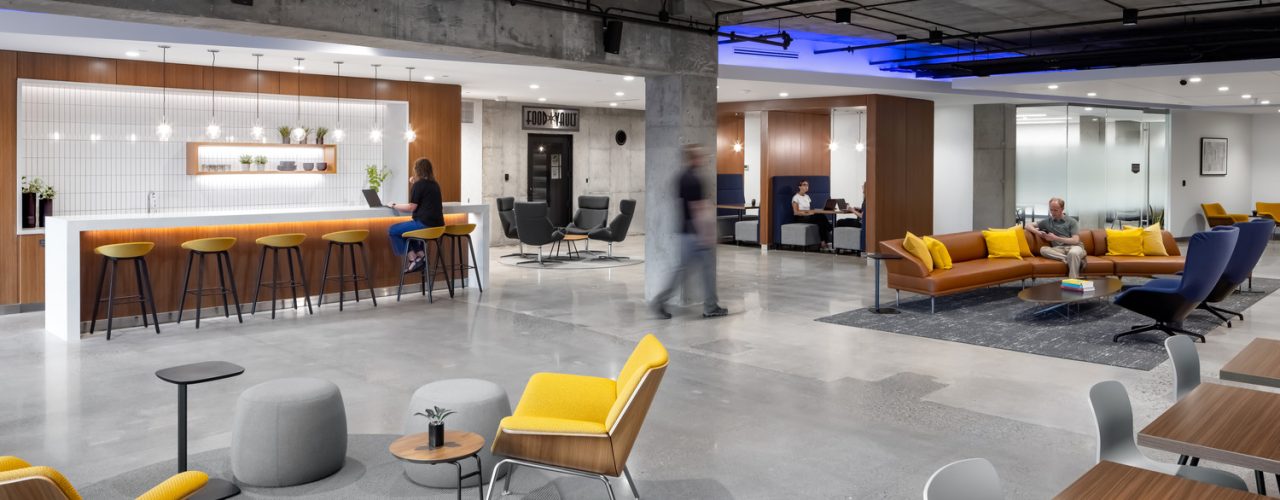How Change Management Has Changed

RSP helps clients manage, communicate and sustain thriving workplace strategies through change management. Here are three ways the last three years have upended what we do.
*This article was originally published in Work Design Magazine.
A lot of things about daily life have gone back to “normal” compared to early 2020. Most of us are going out to restaurants. Going out to the store. And getting back to regular travel. But work? That’s a different story. For most knowledge workers, going back to the office five days a week is now optional. Just three years ago, the idea that 50% of the knowledge workforce would have the choice to work from home would have been almost unimaginable. But after two years of proving that employees could be productive, resilient and happy while working from home, the questions now are, how do we change behaviors for leaders so they can trust employees working from many places? And how do we create excitement for employees to want to work in the office?
To be clear, in-person work is still important. But even now, years after we all first learned what COVID was, a resounding majority of remote-capable employees still prefer to work from home at least a couple of days a week (94% according to a recent Gallup Poll). Employers are reluctant to mandate that they come back in person full time. This both helps avoid massive turnover and, crucially, saves a lot of money on overhead costs.
So, what does that all mean for Change Management professionals and their processes? Quite a bit. We are now in an unprecedented age of work. The hybrid model of combining work at home, work from anywhere, and in-office work is here to stay. Companies need new office footprints, technology, space design and workplace strategies. And since this has never before been attempted at this scale, strong Change Management programs are more important than ever. At the same time, the landscape, tools and philosophy behind Change Management have changed in three specific ways.
1. A Heightened Metabolic Rate
I always like to think of Change Management like a muscle. And that muscle has gotten quite a workout in the last three years. Change Management programs used to come into play during an office move or a campus consolidation. For most organizations, it was something that happened every few years at most. Now? It never seems to stop.
Companies have so many big changes to communicate so rapidly, that Change Management strategies are happening much more frequently and for a much longer period of time.
We are also seeing much faster adoption. In the past, what would have taken multiple meetings, strategy sessions and presentations to help clients get the big picture is now being met with enthusiasm, flexibility and acceptance. As a best practice, we used to do pre-occupancy and ongoing employee surveys every 3, 6 or 9 months to measure satisfaction, behavior change and address any wrinkles that came up. Now, we’re more likely to do these kinds of surveys every 4-6 weeks so that we can quickly refine our plans.
Of course, there are always going to be people who resist. People who want things to go back to the way they were. Back to the days where people of a certain level got their own office and others sat in an open plan. But the benefits of hybrid work, and the autonomy and flexibility that come with it, mean that even the naysayers are a little more open-minded if it means everyone can benefit.
2. The Power Dynamic Has Shifted
It wasn’t too long ago that organizations communicated changes and employees adopted them. Good leaders have always considered the wants and needs of their employees, but at the end of the day, workers who had a problem with the way the business was run were typically invited to find other work. That dynamic has shifted dramatically.
From every direction, including third-party national research, our own client research and an endless supply of anecdotal evidence, employees are essentially refusing to go back to the office five days a week. Even at organizations that are strongly encouraging their people to be in the office at least three days a week, it’s just not happening. To wit, one of our clients, a multi-national company who shall remain nameless, is only seeing 5% of employees come into the office 3-4 days a week. At another, it’s about a third, and that’s after a concerted effort to get people back to the office at least a few days a week; for their workers, it’s closer to 1-2 days a week in the office.
This would have been truly unimaginable a few years ago. But it makes perfect sense. Employees don’t like their jobs or colleagues any less. In fact, we hear over and over again that employee satisfaction is high and productivity is strong. What workers don’t like is their commute. They feel that they can get meaningful collaboration and connection 1-2 days a week and still get back those commuting hours for hobbies, friends or family. And our collective experience of living through a global pandemic has led many people to reprioritize the things in life that are most important to them. People want to work. They want to be good at their jobs. And they want to collaborate with their colleagues. But they don’t want to live at the office and they’re much more willing to vote with their feet at companies that don’t respect that.
3. We’re Getting More Respect
When Change Management strategies go wrong at a large organization, it now makes the news. Although we may be in the waning days of the so-called “Great Resignation,” leaders are now hyper-aware that their workplace strategies and how they communicate them to employees can significantly help or hurt their business.
We are being brought in sooner on project timelines, and no one is thinking about Change Management as an afterthought to be tacked on at the end of a project. There is broad acceptance that Change Management programs are happening earlier, more frequently and lasting much longer. And we are seeing many more organizations with internal Change Management teams implement our strategies for the long term.
In the past, clients would often move into a space and the Change Management strategy would stop a few weeks or months later. They wouldn’t bother with post-occupancy surveys (despite our recommendations!) and just expect that employees would all adapt quickly. Now, ongoing programs with continuous employee engagement are becoming the norm.
The communication starts with the onboarding process for new employees and goes throughout the year. And we are conveying different types of information. Certainly, there is a good amount of communication around how to use the new variety of space types, how to find your desk, and, if you don’t have a permanent space, tips on working in a mobile way and space guidelines. But we are also talking about team and client expectations, how to work as a team when some people are at home and some are in the office, and best practices for virtual meetings. People are seeing the value in what we do. They are talking about it more. And it comes down to the acceptance that even the best workplace strategy is only as good as the change and behavior implementation behind it.
The Office of the Future
I can’t say it enough—many people still underestimate how quickly and how dramatically work has changed. Companies are being much more strategic and thoughtful about their physical office spaces and giving workers more autonomy than ever before. This requires flexibility and an open mindset from leadership. But if we can all be receptive to it, we could be entering a much more intentional, more productive and happier age of work.
About RSP Workplace Strategy
Our workplace strategy team uses a human-centric approach to create offices tailored to our clients’ unique needs. We uncover opportunities for transformation using data and insights to support people, process and place, and reflect company culture and business goals. Read more about RSP Workplace Strategy.
Pictured: The BLOC, Bloomington, MN | Photographer: Brandon Stengel, Farm Kid Studios


